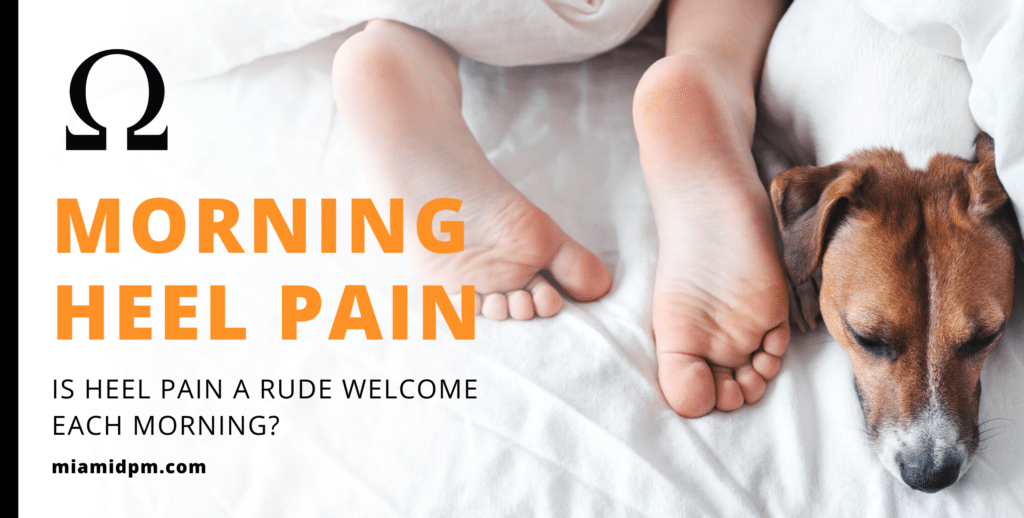What to Do About Morning Heel Pain
You open your eyes in the morning, ready to take on a brand new day!
At least, that’s how it’s supposed to go. Instead, you spend a few minutes beneath your covers gathering the will to simply put your feet on the floor. You know as soon as you do, you’ll be hit with a sharp jolt of heel pain.
You spend the first couple minutes of the day hobbling about until your feet “warm up,” and then you’re all right to get through the day.
… That is, of course, unless you spend enough time sitting at your desk or standing on the job. Start to move again, and that pain is there once more.
Having to deal with this form of heel pain on a day-do-day basis can not only be uncomfortable, but drains your motivation as well. Who is ever excited to get moving when they know they have to pay a pain toll to do so?
If this sounds like your daily situation, you should know that you are far from alone. We see plenty of people with this kind of ordeal all the time. Even better, we have helped most of them find significant and even total relief from their symptoms!
Want to reclaim your mornings? The first stop is understanding what may be going on with your heels.
Meet Plantar Fasciitis
When symptoms include morning heel pain, or pain that arises after a long period of inactivity, one of the most common culprits is plantar fasciitis.
This condition concerns the plantar fascia, a thick band of fibrous tissue that runs along the bottom of your foot. It connects between your heel bone and the base of your toes, and also helps form your arch. It’s a very active and important part of the foot, storing and releasing energy as you walk.
Plantar fasciitis occurs when this band of tissue becomes overly strained or agitated. It can develop very tiny tears, which can cause pain along the heel and arch.
When the plantar fascia has been in motion a while, this pain is not so bad. However, when you rest it—such as giving yourself a good night’s sleep or sitting for a long period of time—the band “cools down” and contracts. When you start moving again, the plantar fascia has to start stretching again, creating that period of pain until it “warms up” once more.
It’s important to understand that having these symptoms does not automatically mean you have plantar fasciitis. There are other conditions that can cause this sort of pain, too, and it’s well worth having it professionally evaluated to know for sure. Plantar fasciitis is often the case, however.
If plantar fasciitis is indeed the diagnosis, the next step is determining how you got it.
What Causes Plantar Fasciitis?
Several factors can contribute to a case of plantar fasciitis. Knowing what they are and properly addressing them is the best way to find the relief you need.
One factor to consider is overuse. Simply put, are you placing too much strain on your plantar fascia via your lifestyle and activities?
For athletes, this might mean that the repetitive impacts of running or other motions are taking a toll on your plantar fascia, and not enough time is being given for recovery and regrowth. You are literally working your plantar fascia too hard!
But you do not need to always be on the move to develop plantar fasciitis. Jobs that require long periods of standing or stooping can also place plenty of pressure on the plantar fascia.
Structure and support should also be considered. Do you have a structural abnormality—such as flat feet—that changes the way weight is distributed across your feet and places more force on your plantar fascia? Or are you wearing footwear that is not providing the right amount of support for your feet?
Treating Plantar Fasciitis
The good news is that, once we lock down the main causes of your plantar fasciitis, we can very often treat it effectively—and without a need for surgery.
No two patients are the same, and we take care to make our best recommendations for heel pain treatment based on the particular situation and needs of each person who comes into our office. Some of our recommendations might include:
- A period of modified and/or lowered activity to help the plantar fascia recover. (We always strive to keep our patients as active as possible throughout recovery, so even if you have to take a short break from your preferred sport, there may be many alternative exercises and activities you can still perform.)
- Icing or medications to help reduce pain and swelling (if any).
- Stretches and exercises to help condition the plantar fascia and what it is connected to.
- The use of splints or to help keep the plantar fascia extended overnight and reduce pain in the morning.
- Changes in footwear and/or activity routines.
- Workplace changes (if possible), such as adding cushioned mats where you stand or time to change positions more often.
- The use of custom orthotics to properly redistribute weight across the feet and take excess stress off the plantar fascia.
In rare cases, conservative treatments may not yield the results we hope for. Surgery might then become a consideration. If it is, we will be certain to discuss all the ins and outs of a recommended procedure to ensure you make the best and most informed choice moving forward.
Take Back Your Mornings (and Other Times of Day) from Heel Pain!
The sooner you take steps to address heel pain, the less of an overall effect it will end up having on your life. Don’t be afraid of losing some time to rest if needed; it’s better than having to endure pain day to day, and risking things becoming worse!
Schedule an appointment at either of our offices in North Miami Beach or Miami Shores by calling (305) 514-0404. We’ll be happy to see you!


